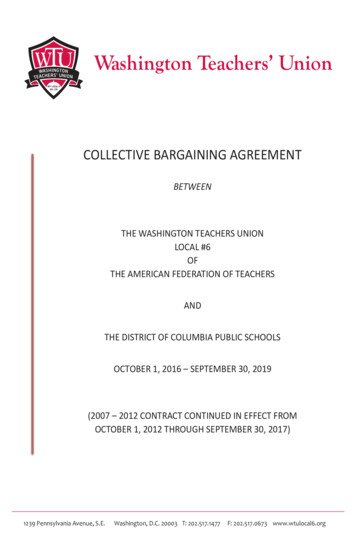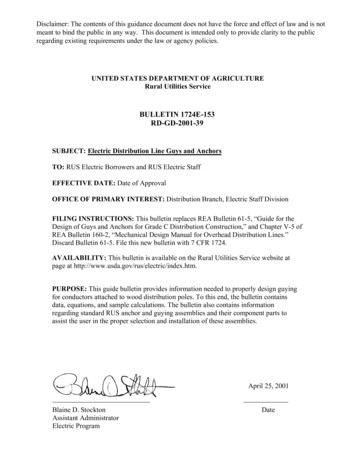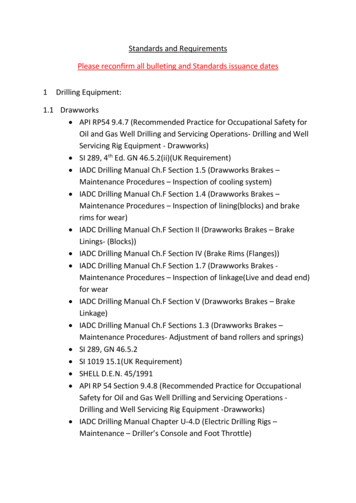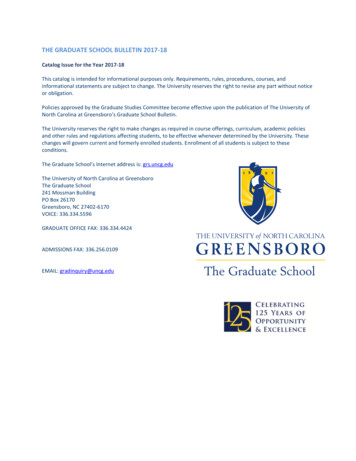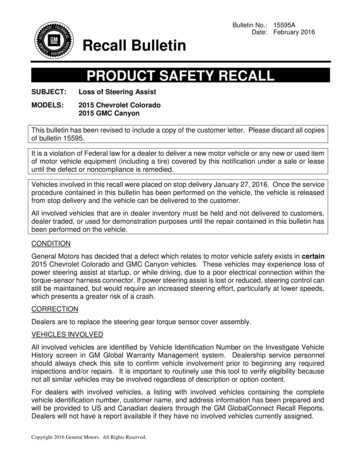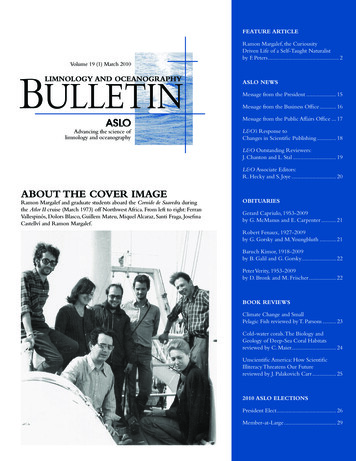
Transcription
FEATURE ARTICLEVolume 19 (1) March 2010BULLETINLIMNOLOGY AND OCEANOGRAPHYAdvancing the science oflimnology and oceanographyRamon Margalef, the CuriousityDriven Life of a Self-Taught Naturalistby F. Peters. 2ASLO NEWSMessage from the President. 15Message from the Business Office. 16Message from the Public Affairs Office. 17L&O’s Response toChanges in Scientific Publishing. 18L&O Outstanding Reviewers:J. Chanton and L. Stal. 19L&O Associate Editors:R. Hecky and S. Joye. 20About the cover imageRamon Margalef and graduate students aboard the Cornide de Saavedra duringthe Atlor II cruise (March 1973) off Northwest Africa. From left to right: FerranVallespinós, Dolors Blasco, Guillem Mateu, Miquel Alcaraz, Santi Fraga, JosefinaCastellví and Ramon Margalef.OBITUARIESGerard Capriulo, 1953-2009by G. McManus and E. Carpenter.21Robert Fenaux, 1927-2009by G. Gorsky and M.Youngbluth.21Baruch Kimor, 1918-2009by B. Galil and G. Gorsky.22Peter Verity, 1953-2009by D. Bronk and M. Frischer.22BOOK REVIEWSClimate Change and SmallPelagic Fish reviewed by T. Parsons. 23Cold-water corals. The Biology andGeology of Deep-Sea Coral Habitatsreviewed by C. Maier. 24Unscientific America: How ScientificIlliteracy Threatens Our Futurereviewed by J. Palakovich Carr. 252010 ASLO ELECTIONSPresident Elect. 26Member-at-Large. 29
The Limnologyand OceanographyBulletinThe American Society of Limnologyand Oceanography is a membershipdriven scientific society (501(c)(3))that promotes the interests of limnology(the study of inland waters), oceanographyand related aquatic science disciplinesby fostering the exchange of informationand furthering investigations throughresearch and education. ASLO alsostrives to link knowledge in the aquaticsciences to the identification and solutionof problems generated by humaninteractions with the environment.Editors: Adrienne Froelich Sponberg,Ph.D., P.O. Box 8785, Silver Spring, MD,20907, USA and John Dolan, MicrobialEcology, Laboratoire d’Océanographie deVillefranche, CNRS & Universite, ParisVI, Station Zoologique, B.P. 28, F-06230Villefranche-Sur-Mer, FranceE-mail: bulletin-editors@aslo.orgASLO Business Manager:Helen Schneider Lemay, ASLO BusinessOffice,Waco,TX, 76710, USA,Tel: 254-399-9635 or 800-929-2756,Fax: 254-776-3767, sing: Helen Schneider Lemay,ASLO Business Manager, Tel: 254-3999635 or 800-929-2756; business@aslo.org 2010 American Society of Limnologyand Oceanography. Material in this issuemay be photocopied by individual scientistsfor research or classroom use. Permission isalso granted to use short quotes, figures, andtables for publication in scientific books andjournals. For permission for any other uses,contact the ASLO Business Office.The L&O Bulletin is published quarterlyby the American Society of Limnologyand Oceanography, 5400 Bosque Blvd.,Suite 680, Waco, TX, 76710, USA. Postagepaid at Waco, Texas. POSTMASTER:Send address changes to ASLO BusinessOffice, 5400 Bosque Blvd., Suite 680,Waco, TX, 76710, USA.Subscription price to regular members isincluded in annual dues. Information oninstitutional subscriptions is available uponrequest from the ASLO Business Office.Views expressed in this publication donot necessarily reflect official positions ofthe American Society of Limnology andOceanography unless expressly stated.The L&O Bulletin publishes brief articlesof broad interest to the ASLO membership, Letters to the Bulletin (typicallyresponses to articles), and ASLO Newson a quarterly basis. Information on thepreparation and submission of articles andletters can be found on the ASLO Web site(www.aslo.org). It is recommended thatyou contact the editors before preparingan article or letter.RAMON MARGALEF, THECURIOUSITY DRIVEN LIFE OFA SELF-TAUGHT NATURALISTFrancesc Peters, Institut de Ciències del Mar, CMIMA (CSIC), Pg. Marítim de la Barceloneta37-49, 08003 Barcelona, Catalunya, Spain; cesc@icm.csic.esPREFACEJanuary 28, 2009, ASLO Aquatic Sciences Meeting, Nice, France: Carlos Duarte approachedme just before half past eight in the morning when we were walking to the Apollon theater toattend the award ceremony and plenary sessions of the day. He asked me if I would be willingto write a short biography of Ramon Margalef, now that ASLO’s Excellence in EducationAward would be named after him. It should be similar to the one Peter Williams had done ofAlfred C. Redfield. I was thrilled, and immediately accepted!Later on I realized the daunting task before me.The international recognition of Margalef asone of the leading ecologists of the 20th century and one of the few great Catalan (Catalunyaor Catalonia is today an autonomous region of Spain with Barcelona as its capital) and Spanishscientists of all times, led to many very well written obituaries and biographical essays by distinguished fellow scientists and disciples. What could I add? I had not been a student of Margalef. Ihad barely met him the first time during Josep M. Gasol’s dissertation defense in 1988 as Margalefwas on the thesis committee. I had only attended a few lectures, seminars or talks. On top of it Ihad to mirror myself in the excellent piece of science history work by Peter leB.Williams.As a biology undergraduate at the Autonomous University of Barcelona I had usedMargalef ’s book Los organismos indicadores en la Limnología (Margalef, 1955) to identify freshwater organisms from the Banyoles area (NE Spain). Also at the university, several of the professorsin botany, biogeography and ecology, had been former students of Margalef, and we usedMargalef ’s textbook Ecología (Margalef, 1974), especially the chapters on diversity and succession. As a graduate student at the Institute of Ecology (Athens, GA, USA) I began to fullyappreciate the influence Margalef had worldwide. When I was asked where I came from andanswered Barcelona, I was immediately associated with Margalef, even if I had not attended theUniversity of Barcelona where he taught. Later on as a postdoc back in Barcelona, this timeat the Institut de Ciències del Mar (ICM), everything was reminiscent of Margalef in ideas,thinking, approach to science, even furniture and experimental setups. I had the opportunityto talk to Margalef but only occasionally and for short informal conversations when he wouldcome to visit the ICM. The dimension of Margalef in my eyes as a scientist and a person wasbecoming increasingly broader. Of course, it helped that I was working on turbulence andplankton, where Margalef is a landmark reference; and also that I got to work with CèliaMarrasé, former graduate student and daughter-in-law of Margalef.I was working on the final report of a project on Sunday, May 23, 2004, when Cèlia calledme to give me the sad news of Margalef ’s death. It was probably only natural that I immediately felt the compelling urge to set up a web-based repository for his work since many of hispublications are not in English or are hard to find. I also felt the need to set up a condolencepage. In a few hours I had a web page ready. Notes from all over the world started to flood in,while I kept adding papers, newspaper obituaries, and miscellaneous information.These were my connections to Ramon Margalef but my question remained: What could Iadd to the biography? The answer still is I do not know. I have tried to read as much informationabout Ramon Margalef as possible from the most varied sources including his own papersand books, interviews and obituaries. I have used the information I have collected since 2004for some data analysis. I have also made extensive use of the biography published by PereBonnín (Bonnín, 1994). Last minute gold nuggets have been an unpublished autobiography(Margalef, unpublished) provided to me by Marta Estrada and a collection of personal lettersbetween Ramon Margalef and Guillem Colom (Mateu, 2009). In addition, I have interviewedmore or less informally family members and scientists who had known Margalef well, and Iam especially indebted to Cèlia Marrasé and Marta Estrada. In case of a conflict in information, I resorted to the most direct source and/or to the source published closest in time to aparticular event. Note that I have made the choice to use the Catalan form of Margalef ’s first2
name Ramon (without accent), since this was Margalef ’s first andnative language and the spelling appearing on his identity cardaccording to his son Ramon Margalef Mir (oral communicationSeptember 4, 2009).With the exception of the biography by Bonnín, all biographical texts or recollections on Margalef that I can think ofhave been written by former students and fellow scientists whoknew Margalef well. Perhaps I have added the view of someonethat was not directly related to him and that knew him scantly,with the obvious danger of missing people, events, or otherimportant aspects of Margalef ’s biography, and I humbly askfor the indulgence of all, including the reader. This has beena wonderful learning experience for me and I have become aconverted margalefian. I thank Carlos Duarte for this opportunity,and above all I thank Ramon Margalef for his legacy.Short 1939-194319431943194419451945September 200919481949FAMILY BACKGROUNDRamon Margalef i López [RML] was born in Barcelona,Catalunya (Spain) on May 16th, 1919. His father, Ramon Margalefi Adell, was a young farmer that moved to Barcelona with hisparents and other family members after the outbreak of phylloxera(Dactylosphaera vitifoliae), a small insect, ruined the family 98419861987198919931995200020042004Ramon Margalef and his sister Vicenta circa 1924. Courtesy of theMargalef family.3Birth of Ramon Margalef – Barcelona, May 16thEnters commerce trade schoolSpanish Civil warForced enrollment into the republican armyJoins the Institució Catalana d’Història NaturalConscripted into the nationalist army (intermittently)Death of his motherFirst scientific publicationScholarship at the Instituto de Biología Aplicada(Consejo Superior de Investigaciones Científicas, CSIC).Completes high school degree – September 21stStarts studies of Natural Sciences at the University ofBarcelonaStays in Italy and SwitzerlandEstablishes a marine lab in Blanes for the CSIC. FirstDirector of this lab.Finishes his university degree – December 9thDoctoral dissertation: Temperatura y morfología de losseres vivosResearch position at the Instituto de InvestigacionesPesqueras (CSIC)Married Maria Mir – July 4thBirth of Neus Margalef i Mir – May 30thBirth of Núria Margalef i Mir – March 18thTwo-month trip to America and talk at ScrippsBirth of Ramon Margalef i Mir – September 14thBirth of Bartomeu Margalef i Mir – January 22ndPublication of Information theory in ecologyLectures at the University of ChicagoDirector of Instituto de Investigaciones PesquerasEcology Chair at the University of Barcelona – June 1stPublication of Perspectives in ecological theoryDeath of his fatherSahara II cruise with the new Spanish research vesselCornide de SaavedraPrince Albert I MedalPublication of textbook EcologíaTrip to Australia; Maria is hospitalized after suffering anaccident – AugustA.G. Huntsman AwardPublication of textbook LimnologíaRamón y Cajal PrizeRetirement as Professor of the University of BarcelonaElected Professor Emeritus of the University ofBarcelona – April 8thNaumann-Thieneman MedalRetirement as Professor Emeritus of the University ofBarcelona – September 30thInternational Ecology Institute PrizeASLO Lifetime Achievement AwardDeath of Ramon Margalef – Barcelona, May 23rdDeath of Maria Mir – May 30th
in the region of Priorat. Ramon Margalef i Adell managed to geta job as a bank clerk and married Vicenta López Viu, who had alsomoved to Barcelona from the region of Aragón. RML only hadone sister,Vicenta, born 1923. She was a dressmaker and tendedher family before suddenly passing away in 1991.RML married Maria Mir Tauler, a biologist from Mallorca,on July 4th, 1952 in the church of Sant Nicolau in Palma deMallorca. They had 4 children. Neus (1953) is a mathematician and high school teacher in Barcelona, Núria (1955) is aphysician in Puigcerdà, Ramon (1956) is a biologist and highschool teacher in Barcelona, and Bartomeu (1958) is devoted tocooperation and at present working in an orphanage in Angola.Seven grandchildren from Neus (3), Núria (2) and Ramon (2).on field trips with the Centre Excursionista de Catalunya(English: Hiking Center of Catalunya), collecting specimensand learning of the relationship of species to particular environments. They were applying to the Institució Catalana d’HistòriaNatural through Mossèn Bataller, who admired their interestand knowledge, when the Spanish [uncivil] war broke out.1936-1939 SPANISH CIVIL WARWhen Margalef was 17, the Spanish Civil war broke out onJuly 18th, 1936. Spain had been a democratic republic onlysince 1931. The reforms needed in a country still quasi-feudal,included distributing land among poor peasants; combined withother sociopolitical movements such as the right of women tovote, the right of historic regions to determine their own political fate, a certain anticlericalism with anarchistic sparks here andthere, and military cutbacks, it created the unrest that resultedin the military rebellion that started the war against the government. There were barricades within the city of Barcelona, severalextremist anarchist groups were burning churches. It was easyfor people to become politically polarized on one side or theother. But Margalef was not interested in politics, and the chaosof the first part of the war was an opportunity for him to getmore and more involved into his naturalist studies. He started towrite his findings with accurate drawings in a rather formal wayas he had seen in the journals he was perusing in the libraries. He made up a fictitious Societat Catalana d’Estudis Biològicsand would bind his papers in two series named Butlletí de laSocietat Catalana d’Estudis Biològics and Publicacions de la SocietatCatalana d’Estudis Biològics. A third journal he made up was ActaHydrobiologica. These papers have never been published.Barcelona was on the republican side of the war, loyal tothe legitimately elected government, but the rebel nationalistswere quickly gaining ground. Ramon was drafted on February22, 1938, at the age of 18. Since he had good writing skills,he was soon given a typewriter, and charged with paperworkand dispatches. He was finally sent to the Ebro river front,site of the longest and bloodiest battle of the war. ApparentlyRamon became ill with fever and diarrhea and was sent back toBarcelona. Just a few days later the war ended with the defeatof the republicans. Josep Maria Marcè died during the war, to thegreat dismay of Ramon.1919-1936 CHILDHOODAND YOUTHAs a child, Ramon used to play in the busy streets of theold Barcelona neighborhoods spending hours just watching merchants trading and loading and unloading all kinds ofgoods. He also enjoyed very much playing in the vacant lotsof the city where he could find puddles of water teaming withlife that he would observe and follow for days. His interest innature was also likely sparked by Sunday visits to the parks andnatural gardens of Barcelona and by helping his father tend asmall backyard orchard with fruit trees, probably a hobby thatreminded his father of his early farming days. Ramon wouldspend hours watching all kinds of ants, caterpillars, beetles andwhat not. He learned to preserve butterflies and would makehis own accurate collections of insects and plants. At school hewas a distracted student, probably thinking all the time aboutthe puddle of water he was exploring or on the next life stagehe would find an insect when later in the day he would be ableto go back to the orchard. Ramon did not have good memoriesof his early school years as he would often be chastised. Despitehis lack of interest for formal school training, he learned to readand write in Spanish and all the other basic skills easily. He evenlearned to write in Catalan on his own by following installmentsappearing in the youth magazine El Patufet.In his early teens Ramon attended a commerce trade school,his father probably reasoning that becoming an accountant orbank clerk as himself would provide Ramon a good living.This was definitely not the track towards a University degree.Apparently Ramon complained that he was not learning much,probably because he was bored after acquiring the knowledgefaster than his classmates and not being genuinely interestedanyhow. Meanwhile, he continued with his naturalistic hobbiesand started to accurately draw and describe species. His fatherworried about Ramon’s apparent lack of progress and hireda private tutor, Alexander Jacky, to help him with his studies.Ramon learned German and French and mathematics with Mr.Jacky, an Alsatian who had also lived in Argentina. This was ablessing for Ramon, now able to read works of the German andFrench naturalists, who had done quite a few studies on faunaand flora in Catalunya. In his later teens, he started to go regularly to the public libraries and to the more specialized librariesin several academic institutions. Ramon and close friend JosepMaria Marcè shared the naturalist’s interests and went together1940-1943 RETURN FROM WARMargalef had very bad memories of the war. It did convincehim that one only lives once and of the need to take advantageof every possible minute to do whatever fulfills one’s genuineinterests. Just after the war, he was drafted again, now into thearmy of the newly installed military regime of general FranciscoFranco, but was soon discharged by reason of his father’s agewho turned sixty. For monetary reasons he took a job at aninsurance company. In the afternoons he would devote everyminute to his naturalist interests. He reconnected with thescientists and the scientific societies he had started to frequentbefore the war, and restarted his field trips. He built his ownmicroscope with bits and pieces he found in flea markets andjunkyards, and started to observe most probably just anythinghe could get his hands on, including aquatic microorgan4
isms. Important Catalan naturalists and scientists, astoundedby Margalef ’s work capacity, his rare self-taught knowledgeacquisition process and his acute intelligence, encouraged him topursue a university degree. Important influences and mentors ofthis time include Mossèn Bataller (Institució Catalana d’HistòriaNatural), Francesc Español (Museu de Zoologia), and Antoni deBolòs and Pius Font i Quer (Institut Botànic de Barcelona).Unfortunately, Margalef would still have to wait somewhatsince in 1941 he was drafted a second time into Franco’s army,this time in artillery. The Second World War (1939 to 1945)threatened to involve each and every European country. Francowas preparing for Spain’s involvement siding with Germanyand Italy but finally managed not to be dragged into the war.Margalef was sent to Mallorca. What did he do in his spare time?An inventory of all freshwater bodies of the island with specialemphasis on microalgae. He also established friendship withMiquel Massutí, director of the Institut Oceanogràfic in Palma,with whom he did a complete study of marine plankton thatlater resulted in a book.In 1943, his mother suddenly died of a stroke and he wasrefused permission to return home for a last goodbye. Laterthat year he was finally discharged from the military. Margalefstopped his unpublished series and published his first threeofficial scientific papers and one science popularization book.In these early publications, the word ecología appears in text andtitles. He was 24 years old.of English, and now with the decline of German naturalistsafter the war, he improved his English skills to delve into theliterature. He was also learning Russian on his own. He did notdevote much time to the social life characteristic of universitystudents. But he did meet Maria Mir, a biology student whowould later become his wife.Margalef finished his university degree in 1949. He was30 years old and had already published 58 papers mostly onzoology and freshwater and marine plankton. While Margalefwas studying, García del Cid was charged by the CSIC (ConsejoSuperior de Investigaciones Científicas) with setting up a marinefisheries institute as marine biology studies were becoming animportant part of the Instituto de Biología Aplicada. He askedMargalef to set up a lab in Blanes (on the Mediterranean coast,70 km north of Barcelona). Facilities and support were providedby Karl Faust, a German with commercial interests in Barcelona,who founded the botanical garden Marimurtra in Blanes. In 1949Margalef was named director of the Blanes laboratory. He gavemarine biology short courses and trained others in the identification and counting of phytoplankton, as the basis of the foodchain. At the same time, he began and maintained a biweeklyphytoplankton time series collection. He analyzed samples andpublished swiftly, and his papers went beyond the descriptioninto the fundamentals of succession, diversity, community structure and ecosystem dynamics. Nonetheless, throughout the lateforties and early fifties he did not hide the fact that his preferredresearch subject was actually limnology and the biology offreshwaters. An almost inexistent taxonomy and systematics ofSpanish freshwater organisms had to be addressed to advance inthe ecological and biogeographic aspects that most interestedMargalef (Mateu, 2009). His job, however, was to do marineresearch and he did it so professionally and with such high and1944-1951 THE STARTOF A CAREER AS A SCIENTISTWith his military service over, Margalef followed the advice of hismentors to pursue a university degree. But there was a problem.Margalef did not have the formal and required seven years ofpre-university training, Bachillerato (equivalent to high school).His mentors smoothed his way by getting him credit for somesubjects from his unfinished trade school studies, and exemptinghim from some classes as long as he took the final exams. In 1944,while studying for his Bachillerato diploma, his mentors helped himget a scholarship to work with Dr. Francisco García del Cid (oneof the Spanish research vessels is nowadays named after him) atthe Instituto de Biología Aplicada in Barcelona. Margalef left hisboring job at the insurance company. His father worried about thisdecision to leave a secure workplace but Margalef was completelydetermined. In 1945, he earned his Bachillerato and it had takenhim only two years! Margalef confessed he had had the hardesttime learning Latin on his own, according to Francesc Vives, afellow university student. Later in 1945 he enrolled in NaturalSciences at the University of Barcelona.At the university, skipping classes was not unusual. In oneclass they had not seen him during the whole academic yearwhen he showed up at the final oral exam. The questions wereharder and harder but Margalef answered them all brilliantly. Theastounded professor gave him Matrícula d’Honor (with honors).With the greatest humility, Margalef was able to leave thetoughest professor of the toughest subject without argumentsto give him less than the highest marks. Besides attending a fewclasses Margalef would devote his time to work and research,writing and reading. It is very likely he already had notionsRamon Margalef and Maria Mir – April 6, 1952. Courtesy of theMargalef family.5
help him with plankton counts. Ramon was a jovial person,maybe a bit on the shy side but with an acute sense of humor.Standing 1.85 m, with a bony complexion, darkish hair anddeep blue eyes, he had a somewhat uncommon physical appearance for the Mediterranean standards of the time. He always hada genuine half smile on his face and would never speak badlyof another person. He loved to play Meccano–the playset ofmetal plates, wheels, nuts, screws–with his children because thepossibilities for constructing imagined devices were endless. Onweekends, the family would often go to the countryside andMargalef would always challenge their children with questionsabout the plants, animals, lichens or geology they were observing; always in a distended, unforced way. His teaching philosophywas to provide plenty of leads for others to follow and explore,but it had to be one’s own willingness to take advantage of thoseleads. At home, when he had one calm minute he would devoteit to writing. At nights he would translate foreign books intoSpanish or write popular science texts to complement a meagerscientist’s salary.With Margalef, the IIP became a full-scale oceanographicinstitution. Under the guidance of director García del Cid, theyset up labs in Castellón (Mediterranean levantine coast of Spain),Vigo (Ría in Northwestern Spain) and Cádiz (on the Atlanticcoast of Southwestern Spain). These labs later became institutesof their own. Margalef would spend time at these labs, especiallyin Vigo and Castellón, staying for months at a time settingup coastal plankton monitoring time series, sampling specificconditions and events and training people. Phytoplanktonsampling would always be accompanied by nutrient samples inorder to relate plankton dynamics to the physical and chemicalenvironment. Each issue of the IIP’s journal Investigación Pesquerausually contained one paper by Margalef and often two or more.The analysis of the data for a given time series would amazingly appear during the next year after sample collection, andnot four, five or more years later as is usual. This was also thebeginning of the “international era” for Margalef and for theIIP. Science funding was really scarce and travel money almostinexistent and difficult to obtain. Chance came Margalef ’s way.By way of García del Cid, he met Sidney Galler, a talent scoutof the American Office of Naval Research and got on wellwith him. Through this connection, he was given basically ablank check for travel expenses through the U.S. Military AidTransportation Service. And did he ever take advantage of it! Hestarted to establish connections with institutions and scientistsworldwide. He visited Italy (Napoli and Pallanza), Switzerland(Zurich), Belgium, Canada (St. Andrews and St. John’s), the U.K.(London, Windermere, Cambridge and Plymouth),Venezuela,Puerto Rico, France, Germany, the United States (Scripps,Yale)and many other places. He traveled to labs and to internationalmeetings. Back at the Institute he would provide detailed reportsof the interesting and novel aspects he had been exposed to inhis travels for anyone to read. Margalef was also given to building devices that he would use for his own research. Some say healso had a blank check to build any devices he wished. This isunlikely, but besides travel coupons he probably received someadditional funding from the U.S. military that would seem muchfor his scantly funded lab fellows.abundant scientific output, that he had no problems in makingcompatible both research lines.After finishing her degree in 1949, Maria went back to hernative Mallorca as a teacher. Ramon visited her whenever hecould. Margalef also started working on his doctorate dissertationthat was titled Temperatura y morfología de los seres vivos, on experimental studies with green microalgae. The official director, Dr.Florencio Bustinza from the University of Madrid (at that timethe only university in Spain allowed to issue doctoral degrees),was a bureaucratic necessity that provided little help. Margalefdid his doctorate basically on his own with occasional aid fromprofessors in Barcelona. In 1951 he defended his dissertation inMadrid. He was 32 years old and had authored 82 publications.1952-1967 THE INSTITUTO DEINVESTGACIONES PESQUERASIn 1952 García del Cid recalled Margalef from Blanes to filla position at the newly founded Instituto de InvestigacionesPesqueras (IIP) in Barcelona. On July 4th he married Maria Mir,and one year later their first daughter, Neus, was born. Threemore children (Núria, Ramon and Bartomeu) would followsoon. Maria was Ramon’s true love but she was also the centerof the family, the lighthouse that guided the growing familyboat in calm and rough seas. She managed the education of theirchildren, the family economy, and the social life and obligations.Ramon, playful with his kids, did not have to worry about thelong-term steering of the family. Maria mentioned once thatshe had never been jealous of the science that absorbed Ramonfor long hours and days. A biologist herself, she would often bethe first critical reader of Ramon’s manuscripts, and occasionallyRamon Margalef and his children (from left to right: Bartomeu,Núria, Neus and Ramon) out in the field circa 1962. Courtesy ofthe Margalef family.6
Margalef was an avid reader, and he would often steer otherscientists towards particular books or papers that were relevantto their research. He was kind and giving and received theadmiration of fellow lab workers. During sampling trips, twoor three scientists and a skipper would fit in small, ill-equippedboats. Margalef would always want to do one more sample, goa bit further offshore, which sometimes got them into troublesince the boats were not prepared for such endeavors. He neverabandoned freshwater studies, whether in local lakes and streamsor in his travels and stays abroad, albeit he acknowledged thatmost of his ecological ideas stem from his experiences in marineenvironments. Margalef, now with his international contacts,jumped to participate in numerous cruises in the
and Oceanography Bulletin The American Society of Limnology and Oceanography is a membership-driven scientific society (501(c)(3)) that promotes the interests of limnology (the study of inland waters), oceanography and related aquatic science disciplines by fostering the exch



